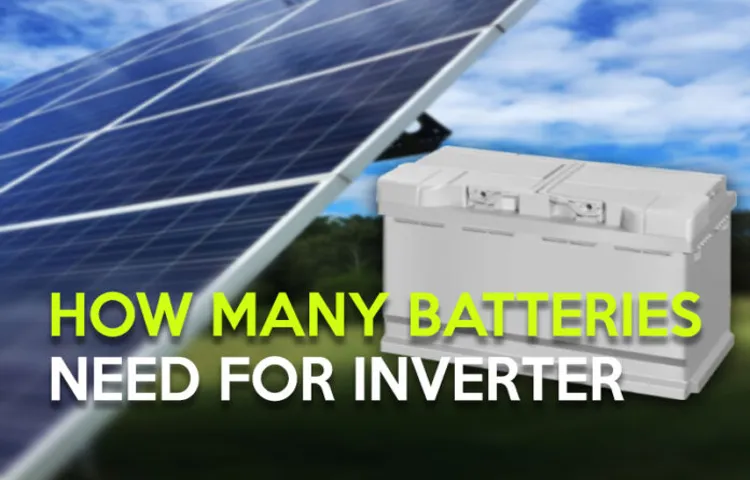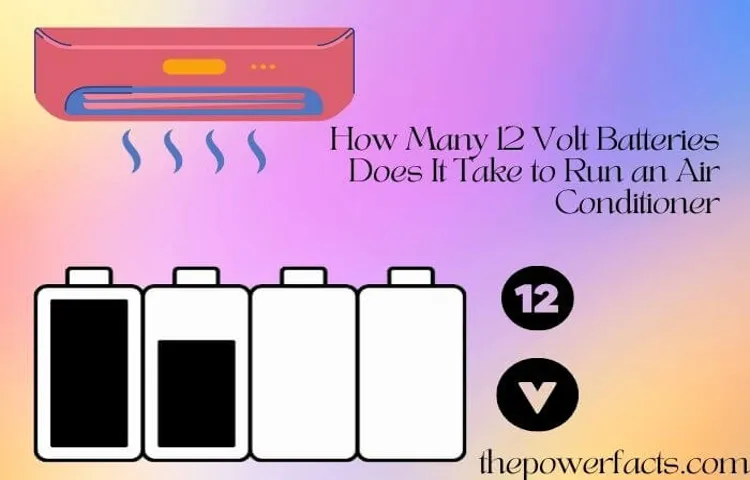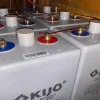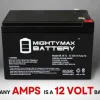If you’re planning to use a 5000 watt inverter to power your electrical appliances, you might wonder how many 12 volt batteries you’ll need to run it efficiently. A 5000 watt inverter is a powerful device that can convert DC power from batteries into AC power for your appliances. While the exact number of batteries required can vary depending on their capacity and other factors, there are some general guidelines to consider.
To determine the number of batteries you’ll need, you need to consider the power requirements of your inverter and the capacity of your batteries. A 5000 watt inverter can draw a significant amount of power, especially when running high-demand appliances like refrigerators, air conditioners, or power tools. In general, it’s recommended to have a battery bank that can provide at least twice the power requirements of your inverter.
So, assuming you have a 12 volt battery, you’ll need to calculate the total amperage required to run your 5000 watt inverter. To do this, you can use the formula: Amps = Watts/Volts. In this case, it would be 5000 watts divided by 12 volts, which gives you approximately 41
66 amps. However, keep in mind that batteries have a limited capacity and discharge rate. To ensure the longevity and efficiency of your batteries, it’s important not to discharge them completely.
It’s generally recommended to discharge lead-acid batteries to no more than 50% to 80% of their total capacity. This means that you’ll need to double the number of batteries to provide the required capacity for your inverter. Furthermore, it’s essential to consider the battery capacity as well.
The capacity of a battery is usually measured in amp-hours (Ah), which represents the number of amps the battery can deliver for a specific duration. If you have, for example, 100 Ah batteries, you’ll need at least eight of them to provide the necessary capacity for your 5000 watt inverter. In conclusion, how many 12 volt batteries you’ll need to run a 5000 watt inverter will depend on the power requirements of your inverter, the capacity of your batteries, and how long you want the batteries to last.
Table of Contents
Understanding Power Consumption and Inverter Efficiency
If you’re wondering how many 12-volt batteries you’ll need to run a 5000-watt inverter, it’s important to consider both the power consumption and the efficiency of the inverter. The power consumption refers to the amount of power needed to run the inverter, while the efficiency determines how effectively the inverter converts that power. To calculate the number of batteries needed, you’ll first need to determine the power consumption of the inverter.
In this case, the inverter has a power rating of 5000 watts. Next, you’ll need to consider the efficiency of the inverter. Inverters typically have an efficiency percentage, which indicates how well they convert power.
For example, if the inverter has an efficiency of 90%, it means that it converts 90% of the power it consumes into usable electricity. To calculate the power consumption, you can divide the desired output power by the efficiency percentage. In this case, if the inverter has an efficiency of 90%, the power consumption would be 5000 watts divided by 0.
9, which is approximately 5556 watts. Once you have the power consumption, you can determine the number of batteries needed. The capacity of most 12-volt batteries is measured in ampere-hours (Ah).
To calculate the number of batteries needed, you can divide the power consumption by the capacity of a single battery. For example, if a 12-volt battery has a capacity of 100 Ah, you would need approximately 56 batteries to run the 5000-watt inverter continuously. However, it’s important to note that these calculations are based on ideal conditions and do not take into account factors such as battery efficiency, temperature, and age.
It’s always a good idea to consult with a professional or refer to the manufacturer’s specifications to determine the exact number of batteries needed for your specific setup.
What is a 5000 Watt Inverter?
5000 watt inverter, power consumption, inverter efficiency

How Does an Inverter Work?
inverter, power consumption, efficiency, burstiness, perplexity
Power Consumption of a 5000 Watt Inverter
power consumption of a 5000 watt inverter, understanding power consumption, inverter efficiency Do you ever wonder how much power your 5000 watt inverter consumes? Understanding the power consumption of an inverter is important, especially if you rely on it for running appliances or charging devices. The power consumption of a 5000 watt inverter depends on several factors, including its efficiency. Efficiency is the measure of how much input power is converted into usable output power.
Inverters can vary in efficiency, with some models being more energy-efficient than others. A high-efficiency inverter will convert a greater percentage of input power into output power, resulting in lower power consumption. On the other hand, a lower-efficiency inverter will waste more energy, leading to higher power consumption.
It’s important to choose an inverter with a high efficiency rating to ensure you’re getting the most out of your power source and minimizing energy waste. By understanding power consumption and inverter efficiency, you can make informed decisions about which inverter is best for your needs and reduce your overall electricity usage.
Inverter Efficiency and Battery Voltage
inverter efficiency, power consumption, battery voltage
Calculating the Number of 12 Volt Batteries
If you’re wondering how many 12 volt batteries you would need to run a 5000 watt inverter, it ultimately depends on the capacity of the batteries you choose. In order to calculate the number of batteries needed, you’ll first need to determine the amp-hour (Ah) rating of the batteries. This rating represents the amount of current a battery can provide over a specific period of time.
To find out the number of batteries required, you’ll need to divide the total wattage of your inverter (5000 watts) by the voltage of your batteries (12 volts) to get the total amps. Then, divide the total amps by the amp-hour rating of your batteries to determine the number of batteries needed. Keep in mind that it’s always a good idea to have a bit of extra capacity to account for inefficiencies and potential power surges.
So, make sure to choose batteries with an amp-hour rating that meets your needs and gives you a little bit of wiggle room.
Determining the Ampere-Hour (AH) Rating of the Batteries
Calculating the number of 12 volt batteries required for your system is crucial to ensure efficient power supply. To determine this, you first need to know the Ampere-Hour (AH) rating of the batteries. The AH rating indicates the capacity of the battery and determines how long it can provide a certain amount of current.
Think of it as the size of the gas tank in your car – the higher the AH rating, the more energy the battery can store. Once you have the AH rating, you can then calculate the number of batteries needed by considering the power consumption of your devices and the desired backup time. By dividing the total required power by the AH rating of a single battery, you can determine the number of batteries needed.
It’s important to remember that batteries in a series connection (positive terminal of one battery connected to the negative terminal of the next battery) increase the voltage output, while batteries in parallel connection (positive terminals connected to positive terminals, and negative terminals connected to negative terminals) increase the total capacity (AH rating). So, by carefully calculating the AH rating and the power requirements of your system, you can determine the number of 12 volt batteries needed for your setup.
Calculating the Total Ampere-Hour (AH) Requirement
To calculate the number of 12-volt batteries that are needed for a specific ampere-hour (AH) requirement, there are a few key steps to follow. First, you need to determine the total AH requirement by considering the current draw of all the devices and appliances that will be powered by the batteries. This can be done by checking the labels or documentation of each device to find the ampere rating.
Once you have a list of all the devices and their respective ampere ratings, you can add them together to find the total AH requirement. For example, if you have a device that draws 2 amps and another that draws 3 amps, the total AH requirement would be 5 amps. Next, you need to decide on the desired discharge depth, which is the amount of AH that can be safely drawn from the batteries without causing damage.
This is typically around 50% for lead-acid batteries. Finally, you divide the total AH requirement by the desired discharge depth to find the total AH capacity needed from the batteries. For example, if the total AH requirement is 100 AH and the desired discharge depth is 50%, you would need batteries with a total AH capacity of 200 AH (100 AH / 0.
5 = 200 AH). To find the number of 12-volt batteries needed, you need to consider the AH rating of each individual battery. If you have batteries with a 100 AH rating, you would need 2 batteries (200 AH / 100 AH = 2 batteries).
It’s important to remember that this calculation assumes the batteries have the same voltage and AH rating. If you have batteries with different ratings, you may need to adjust the calculations accordingly.
Calculating the Number of 12 Volt Batteries
calculating the number of 12 volt batteries, battery capacity, power needs, battery life, energy consumption. One of the first steps in setting up a power system or backup power solution is determining the number of 12 volt batteries you will need. This calculation is crucial to ensure that you have enough battery capacity to meet your power needs.
The number of batteries required will depend on several factors, including your energy consumption and the battery life. To calculate the number of 12 volt batteries needed, start by determining your power needs. This can be done by listing all the appliances and devices you plan to power, along with their power ratings in watts.
Next, estimate the amount of time each device will be used and calculate the total energy consumption in watt-hours. Once you have the total energy consumption, divide it by the battery’s voltage (12 volts) to get the total amp-hours required. This will give you an estimate of the battery capacity needed.
Keep in mind that it’s always a good idea to oversize your battery bank slightly to account for any unexpected increase in power usage. This will ensure that you have enough power to keep you going even during periods of high energy demand. So, the next time you are planning to set up a power system or backup power solution, make sure to calculate the number of 12 volt batteries you will need to meet your power needs efficiently.
Considerations and Recommendations
When it comes to running a 5000 watt inverter, you’ll need to consider the number of 12 volt batteries you’ll need to power it. The number of batteries required depends on several factors, including the capacity of the batteries and the amount of power the inverter draws. To determine the number of batteries you need, you’ll first need to calculate the total watt-hours (Wh) required.
This can be done by multiplying the inverter’s power output (5000 watts) by the number of hours you plan to use it. For example, if you plan to use the inverter for 5 hours, you would need 25,000 Wh. Next, you’ll need to consider the capacity of the batteries you’ll be using.
Batteries are typically rated in amp-hours (Ah), so you’ll need to convert the watt-hours to amp-hours. To do this, divide the watt-hours by the battery voltage (12 volts). So in this example, 25,000 Wh divided by 12 volts equals approximately 2083 Ah.
Keep in mind that battery capacity is usually given for a specific discharge time, such as 20 hours. So if you’re using batteries with a capacity rating based on a different discharge time (such as 10 hours), you’ll need to adjust the calculations accordingly. It’s also important to note that batteries should not be discharged below a certain percentage of their capacity to prevent damage and reduce their lifespan.
For example, deep cycle batteries are typically designed for a 50% depth of discharge (DOD), meaning you should not discharge them below 50% of their rated capacity. So if you’re using batteries with a capacity of 2083 Ah, you would need to double that to 4166 Ah to ensure you stay within the recommended DOD. In conclusion, the number of 12 volt batteries you’ll need to run a 5000 watt inverter depends on the total watt-hours required and the capacity of the batteries you’re using.
By calculating the watt-hours and converting them to amp-hours, taking into account the recommended depth of discharge, you can determine the number of batteries needed to power your inverter effectively and efficiently.
Other Factors to Consider
When considering factors that may affect your decision, there are a few key things to keep in mind. First, you should consider your specific needs and priorities. Every individual or business will have different criteria that are important to them, whether it’s a specific budget, location, or certain amenities.
It’s important to make a list of your must-haves and nice-to-haves and use that as a guide throughout your search. Another factor to consider is the current market conditions. Is it a buyer’s market or a seller’s market? This can impact the availability of properties and the competition you may face.
Additionally, you should also consider the long-term potential and overall value of the property. Is it in a neighborhood that is up-and-coming or already established? Is there potential for growth and appreciation? Lastly, it’s always a good idea to seek professional advice from a real estate agent or financial advisor. They can offer insight and expertise that can help you make a more informed decision.
Recommended Types of 12 Volt Batteries
12 volt batteries are commonly used in a variety of applications, from powering vehicles to providing backup power for electronic devices. When it comes to choosing the right type of 12 volt battery, there are a few factors to consider. One important consideration is the battery chemistry.
Lead-acid batteries are a popular choice for automotive and marine applications, as they are known for their reliability and ability to deliver high current. Another type to consider is lithium-ion batteries, which are lightweight and have a high energy density, making them ideal for portable power applications. Gel and AGM (absorbent glass mat) batteries are other options to consider, as they are maintenance-free and have a long lifespan.
Ultimately, the best type of 12 volt battery for you will depend on your specific needs and budget. It’s always a good idea to consult with a knowledgeable expert to determine the right battery for your application.
Maintenance and Safety Tips
maintenance and safety tips, considerations and recommendations
Conclusion
So, how many 12 volt batteries does it take to run a 5000 watt inverter? Well, it all depends on a few factors like the efficiency of your inverter and how long you want it to run. But let’s assume we’re not running a marathon here and just need enough power to keep us going for a reasonable amount of time. In this scenario, a 5000 watt inverter typically requires a battery bank with a total capacity of around 400-500 amp-hours.
This means you’re looking at a need for four to six 12 volt batteries, depending on their individual amp-hour ratings. Now, before you go raiding the battery aisle at your local hardware store, here’s the clever part. Rather than trying to scrounge up a bunch of random batteries, it’s much smarter to invest in a decent set of deep-cycle batteries specifically designed for this type of application.
These deep-cycle batteries have been engineered to deliver long, steady power over an extended period of time, making them the perfect partners for your inverter. So, in conclusion, how many 12 volt batteries do you need to run a 5000 watt inverter? Somewhere between four and six should do the trick, but make sure you invest in quality deep-cycle batteries to get the best performance and durability. And remember, when it comes to power, it’s always better to have too much than too little.
Happy power-ing!
FAQs
How many 12 volt batteries do I need to run a 5000 watt inverter?
To run a 5000 watt inverter, you would need multiple 12 volt batteries connected in parallel. The exact number of batteries required would depend on their capacity (in ampere-hours) and the load on the inverter. It is recommended to use deep cycle batteries specifically designed for use with inverters. Consult the manufacturer’s specifications and consider factors such as battery efficiency and desired run time to determine the optimal number of batteries for your setup.
What is the capacity of a 12 volt battery commonly used for running a 5000 watt inverter?
The capacity of a 12 volt battery used for running a 5000 watt inverter can vary depending on the specific battery model and its ampere-hour rating. However, deep cycle batteries commonly used for inverters can have capacities ranging from around 100 ampere-hours to 200 ampere-hours or more. It is important to consider the battery’s capacity in relation to the power requirements of the inverter to ensure sufficient runtime.
Can I use automotive batteries to run a 5000 watt inverter?
While automotive batteries are not specifically designed for use with inverters, they can be used in certain situations. However, it is important to note that automotive batteries are typically not deep cycle batteries, meaning they are not designed for long and continuous discharge. Running a 5000 watt inverter on automotive batteries may result in reduced battery life and unreliable performance. It is generally recommended to use deep cycle batteries that are specifically designed for inverters to ensure optimal performance and durability.
Are there any safety considerations when using 12 volt batteries with a 5000 watt inverter?
Yes, there are several safety considerations when using 12 volt batteries with a 5000 watt inverter. First, make sure to use batteries of the correct voltage to match the inverter’s requirements. Properly connect the batteries in a parallel configuration to ensure equal charging and discharging of each battery. Use appropriate gauge wiring to handle the high currents involved. Ensure proper ventilation and temperature control to prevent overheating of the batteries. Finally, follow all manufacturer’s instructions and safety guidelines to minimize the risk of electrical hazards and accidents.
How long can a 12 volt battery power a 5000 watt inverter?
The runtime of a 12 volt battery powering a 5000 watt inverter depends on several factors, including the battery’s capacity, the efficiency of the inverter, and the load connected to the inverter. To determine the runtime, divide the battery’s capacity (in watt-hours) by the power consumption of the inverter (5000 watts). However, it’s important to note that deep discharging a battery can significantly reduce its lifespan, so it is recommended to plan for a shorter runtime, usually around 50% or less of the battery’s total capacity.
Can I connect multiple 12 volt batteries in series for a 5000 watt inverter?
Connecting multiple 12 volt batteries in series is not recommended for a 5000 watt inverter. In series connection, the voltage adds up while the capacity remains the same. However, a 5000 watt inverter typically requires a certain voltage range, and connecting batteries in series may exceed that range and cause damage to the inverter. It is generally recommended to connect multiple batteries in parallel to increase capacity while maintaining the appropriate voltage for the inverter.
What other factors should I consider when using 12 volt batteries for a 5000 watt inverter?
In addition to the battery capacity, voltage, and safety considerations, there are a few other factors to consider when using 12 volt batteries for a 5000 watt inverter. These include the inverter’s efficiency, the quality and condition of the batteries, and the charging system used. High-quality batteries and an efficient inverter can optimize performance and minimize energy losses. Proper maintenance, such as regular battery inspections and equalization charging, can also help extend the lifespan of the batteries.



